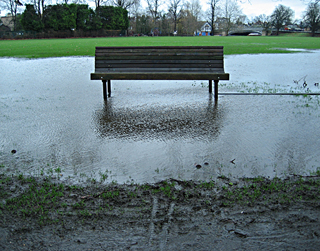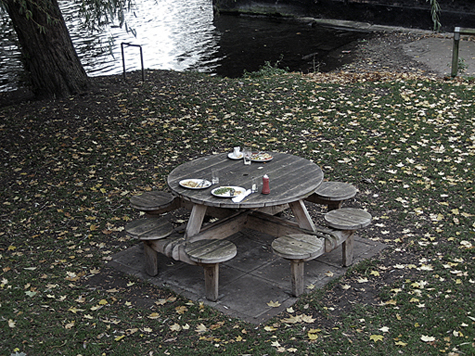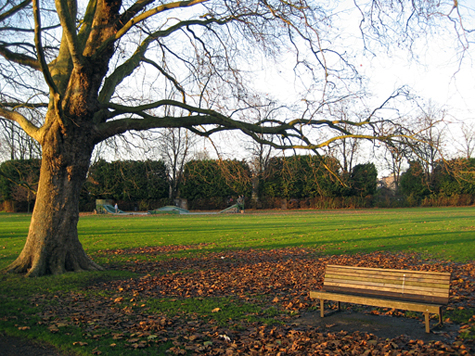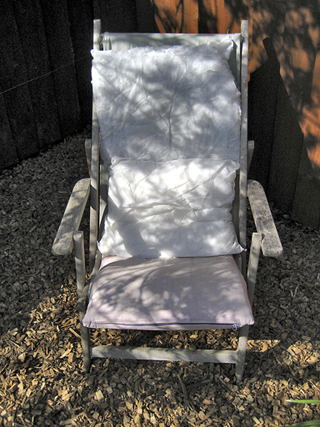Human Flower Project
The Book Club
To gardening books read, and to the right places for reading, at last, the others.

Essay and Photos by John Levett
There are times when it’s a fine thing to read books in context—Orwell in Wigan, Plath on a Yorkshire Moor, George Mackay Brown in Orkney, Proust in Montmartre, Patrick Hamilton in Earls Court, Isherwood in Berlin. I’m not sure of the legitimacy of Proust in Montmartre but the idea suits and I only ever got as far as the north bank of the Firth of Forth with G.M. Brown but, with the light in the right place at the right time of day, coincidence can add to words on the page.
Last week I went for a day’s walk and by late afternoon I was sitting on a hill near Fowlmere, a small village south of Cambridge, reading Mollie Panter-Downes’s ‘One Fine Day.’ It describes the commonplace events of a day in the life of a middle-class woman one year after the end of the last war and her balancing between resignation to the petty restrictions and inconveniences of Britain in austerity and the bright certainty of a future. I had arrived at this passage: “… never, even then, had Laura felt quite this rush of overwhelming thankfulness, so that the land swam and misted and danced before her. She had had to lose a dog and climb a hill, a year later, to realize what it would have meant if England has lost. We are at peace, we still stand, we will stand when you are dust, sang the humming land in the summer evening.” There was a dull drone gathering and shortly I was overflown by a Spitfire and Hurricane from (I guessed) the Battle of Britain flight up in Lincolnshire. Check the ration book then home to tea scrapings and margarine on toast.

I think of Mollie’s Laura as cousin to Laura in David Lean’s 1945 ‘Brief Encounter’; living comfortably in a small market town, husband (a demobbed Major) works in the bank, mortgage accounted for, meeting a friend for afternoon tea, visiting Boots Booklovers Library, balanced and compliant children suitably in the background, unsure of what the war has wrought. Some while ago, preparing for a course I was to give on post-war social history, I spent a year reading British novels of the late 40s. It was attitudes, the demands of social class, expectations of speech and behaviour, insecurities of position, conventions of deference—the psychological exertions of negotiating a life—that engaged me. It was also about what the book told me about its readership—the difference between ‘The Ragged Trousered Philanthropists’ reader and a Somerset Maugham.

Decades ago I joined clubs; taken in by the introductory offer; ordering stuff beyond means both financial and temporal. Wine club, cheese club, hamper club, Christmas club, seed club, stamp club, record club. And the inevitable book club—all the remainders you could carry, to be had at a snip. Club enthusiasm fell off after the ‘Just-like-Christmas-when I-was-a-kid’ kick of seemingly-daily deliveries and only came back with the ‘Store Now Open’ early days of Amazon and eBay.
I admit to being a dupe for all of the above but I had eyes wide open when I joined The Gardeners’ Book Club. This surely was a worthy investment. I had the essential garden, was open minded, up for any idea, try anything year upon year and tear upon tear. Practically, I fell foul frequently of the ‘The Book of the Month will be sent automatically unless we are advised otherwise’ small print and the ‘Out of print for fifty years but now available with …’ that always appealed to the ‘historical’ gardener within.
 Yearly I take books to charity but I seem to have retained everything garden-related, even guidance on cultivating a small-holding and livestock (must have been a ‘twofer’). Most got flicked through at the time and during my annual turn-out or turn-over-and-replace they only get a further flick through. This year I got to thinking about which, if any, of my gardening books have ever got read and cherished. There are some and these are those.
Yearly I take books to charity but I seem to have retained everything garden-related, even guidance on cultivating a small-holding and livestock (must have been a ‘twofer’). Most got flicked through at the time and during my annual turn-out or turn-over-and-replace they only get a further flick through. This year I got to thinking about which, if any, of my gardening books have ever got read and cherished. There are some and these are those.
Top of the pile is ‘Roses’ by Jack Harkness. It’s what a lifetime in roses from apprenticeship to death can produce. It’s by a man who was as part of rose history as those he writes about. It’s anecdotal, authoritative, opinionated, out of step with modernity. It was published in 1978 and, to my knowledge, has never gained a reprint. That’s good; it means that any day it will be a wonderful discovery for someone whilst rummaging in a second-hand shop.
 Next come the classic rose books by Graham Stuart Thomas: ‘The Old Shrub Roses’ (1955), ‘Shrub Roses Today’ (1962), ‘Climbing Roses Old and New’ (1965). They can still be found in their original editions but were gathered under one roof of ‘The Graham Stuart Thomas Rose Book’ in 1994. Each book fits in the same category as that of Harkness’s—it’s not just facts about a rose or its grower, it’s the detours and the rests he makes; seeing the connections, how one rose emerged as key to another half a century later, the insights of the grower, the search for origins. In a single paragraph on ‘Hume’s Blush Tea-Scented China’ (1809) he covers the East Indies, Colville’s Nursery, Empress Josephine, Malmaison, Redouté, R. indica fragrans, R. chinensis, R. gigantea, Bourbon, Noisette and Yellow China roses and the fact that it likely had fourteen chromosomes.
Next come the classic rose books by Graham Stuart Thomas: ‘The Old Shrub Roses’ (1955), ‘Shrub Roses Today’ (1962), ‘Climbing Roses Old and New’ (1965). They can still be found in their original editions but were gathered under one roof of ‘The Graham Stuart Thomas Rose Book’ in 1994. Each book fits in the same category as that of Harkness’s—it’s not just facts about a rose or its grower, it’s the detours and the rests he makes; seeing the connections, how one rose emerged as key to another half a century later, the insights of the grower, the search for origins. In a single paragraph on ‘Hume’s Blush Tea-Scented China’ (1809) he covers the East Indies, Colville’s Nursery, Empress Josephine, Malmaison, Redouté, R. indica fragrans, R. chinensis, R. gigantea, Bourbon, Noisette and Yellow China roses and the fact that it likely had fourteen chromosomes.
 The last of the rose books is Peter Beales’ ‘Classic Roses’. I bought all but one of my rose collection from Peter Beales’ nursery in Norfolk where he did his apprenticeship at LeGrice’s nursery in North Walsham. It’s a book that can look like a catalogue at first glance but as a reference for becoming a rose grower it was outstanding. If I ever build another rose garden I’ll start with it.
The last of the rose books is Peter Beales’ ‘Classic Roses’. I bought all but one of my rose collection from Peter Beales’ nursery in Norfolk where he did his apprenticeship at LeGrice’s nursery in North Walsham. It’s a book that can look like a catalogue at first glance but as a reference for becoming a rose grower it was outstanding. If I ever build another rose garden I’ll start with it.
One book that I no longer have but still cherish the memory of was ‘The Englishwoman’s Garden’ by (I think) Rosemary Verey published around 1980. I discovered it through a (now lost) friend with whom I planned an imaginary garden which we’d share when the boat came in. In my memory of the book, the gardens were grand, mostly aristocratic or with spaces that echoed it, had serious histories and were out of my price range but it was small details that I could pick up and run with that fascinated—a brick pathway, an unsupported bower, a single bloom in a worn earthenware pot, a wooden raised bed built from long felled or fallen trees, an aged bed where there can be no substitute for age. It was the promise of allowing a garden to mature in its own space that slowed my expectations of how ‘our’ garden might become.
 Jane Brown is a fine writer. She wrote ‘Gardens of a Golden Afternoon’ about the relationship between Gertrude Jekyll and Edwin Lutyens but I have too ‘Vita’s Other World’ (1985): a gardening biography of Vita Sackville-West from Knole through to Sissinghurst. I have a first edition of Vita’s long poem ‘The Land’ which was published in 1926. It’s been rubbished for decades but I still keep it to read when travelling down that way. My favourite of Jane Brown’s writing is ‘The English Garden: through the 20th century’ (first published as The English Garden in our Time’ in 1986)—Munstead Wood, Sissinghurst, Hidcote, Sutton Place and the work of Geoffrey Jellicoe.
Jane Brown is a fine writer. She wrote ‘Gardens of a Golden Afternoon’ about the relationship between Gertrude Jekyll and Edwin Lutyens but I have too ‘Vita’s Other World’ (1985): a gardening biography of Vita Sackville-West from Knole through to Sissinghurst. I have a first edition of Vita’s long poem ‘The Land’ which was published in 1926. It’s been rubbished for decades but I still keep it to read when travelling down that way. My favourite of Jane Brown’s writing is ‘The English Garden: through the 20th century’ (first published as The English Garden in our Time’ in 1986)—Munstead Wood, Sissinghurst, Hidcote, Sutton Place and the work of Geoffrey Jellicoe.

A book that tells me I don’t visit enough gardens is ‘Gardens of Inspiration’ (2001). It’s a collection of essays by such as John Brookes, Beth Chatto, Rosemary Verey, Anna Pavord, Christopher Lloyd. It’s also a book that reminds me I’m a dipper-into of gardening books. Of those I have mentioned I can recall only reading Jack Harkness’s from cover to cover in one gulp and I think my problem is finding the right space to read.
Rather than read about Kierkegaard wandering through Gendarmenmarkt on the way to a lecture by Schelling I’d rather be sitting there reading him; rather have sailed the Aegean and be on the shores of Troy by the Scamander reading the Iliad; rather be walking the Hindu Kush reading Eric Newby (but maybe not this minute); rather be in the garden than reading about it.
 My reading habits are strange to me. I’ll read Vita’s gardening columns in my deckchair but struggle with anything longer. Graham Thomas I dip into; I’ve read all of him but never in sequence. I read Beth Chatto’s correspondence with Christopher Lloyd but never read two consecutive chapters of her books (I’ve got three somewhere). Any book I have on Monet’s garden I read by the season; ‘Derek Jarman’s Garden’ I read through four consecutive summer holidays down on the Kent marshes; Vivian Russell’s photography draws me in to a chapter on Villa Chigi Cetinale which I’d otherwise ignore.
My reading habits are strange to me. I’ll read Vita’s gardening columns in my deckchair but struggle with anything longer. Graham Thomas I dip into; I’ve read all of him but never in sequence. I read Beth Chatto’s correspondence with Christopher Lloyd but never read two consecutive chapters of her books (I’ve got three somewhere). Any book I have on Monet’s garden I read by the season; ‘Derek Jarman’s Garden’ I read through four consecutive summer holidays down on the Kent marshes; Vivian Russell’s photography draws me in to a chapter on Villa Chigi Cetinale which I’d otherwise ignore.
Maybe it’s modern publishing. The contemporary format of the garden book isn’t slip-into-a-pocket any more. I’ve got many of the old Penguin guides from decades ago which still give service as well as inspiration alongside hard graft; they’re useful reminders that gardening involves muck.
I don’t get to enough gardens anymore. I don’t run a car anymore. Cambridge doesn’t need one; travelling into London takes less than an hour; I’ve got a free bus pass valid throughout the kingdom. No car equals great smugness but works against spontaneity; no popping up to the Lincolnshire Wolds on a whim. Going through these books again tells me I’m missing something. It tells me that there are some gardens I know only through books. That’s daft for a gardener. A season’s coming to an end but for any present or past teacher September’s always a new start. Anglesey Abbey’s a morning’s walk away; I’ll start.
Comments
John, like you, I free-cycle or donate my “excess” books except the tree and garden books. On a rainy (or in a few months, snowy) day when I’m stuck inside, under a blanket, on the couch, I can turn pages, imagining myself out and about identifying trees, picking up leaves for pressing, getting my nose dusty with pollen, and planning a grander garden than my current one.
(My current garden consists of three pots, indoors.)
John, in your wonderful piece, there was such an astounding breadth of literature, gardens and places so near and far. I read Eric Newby’s Hindu Kush adventure story this year and dream to travel there one day – not now. And Derek Jarman’s little cottage garden – an extraordinary place – came alive again. Thank you so much.
and there i was, unadventurously grateful that i WASN’T reading the ‘Road to Oxiana’ in Afghanistan..


Okay, what’s a hamper club?